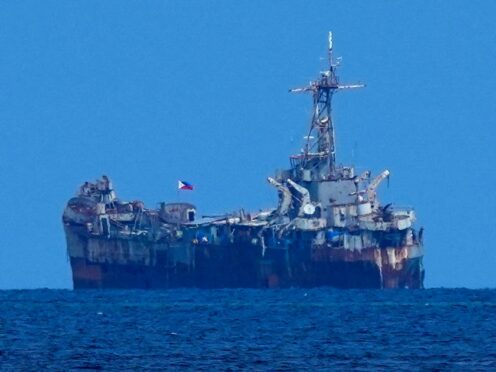
Chinese forces seized two Philippine rubber boats that were delivering food and other supplies to a military outpost in a disputed South China Sea shoal in a tense confrontation in which some Filipino navy personnel were injured, Philippine security officials said on Tuesday.
The United States renewed a warning that it is obligated to defend the Philippines, a treaty ally, a day after the hour-long hostilities in Second Thomas Shoal.
The shoal has been occupied by a small Philippine navy contingent aboard a long-grounded warship that has been closely monitored by China’s coast guard and navy in a years-long territorial standoff.
There is fear that territorial disputes in the South China Sea, long regarded as an Asian flashpoint, could escalate and pit the United States and China in a larger conflict. China and the Philippines blamed each other for Monday’s hostilities, the most serious in recent months, but provided few details.

A Philippine government task force overseeing the territorial disputes condemned what it said were “dangerous manoeuvres, including ramming and towing”, which disrupted an effort to transport food, water and other supplies to the Filipinos manning the territorial outpost on the grounded ship, the BRP Sierra Madre, at the shoal. It did not elaborate.
Two Philippine security officials told The Associated Press that two rubber boats manned by Filipino navy personnel had approached the BRP Sierra Madre at the shoal to deliver fresh supplies when several Chinese Coast Guard personnel on speedboats arrived to disrupt the mission, sparking a scuffle and collisions.
At least eight of the Filipinos were injured, including one who lost a thumb, in the scuffle, said one of the officials.
Five of the injured sailors were rescued by a Philippine Coast Guard patrol ship that was waiting at a distance to back up the navy’s supply mission.
The two rubber supply boats were towed away by Chinese Coast Guard personnel and then abandoned after being damaged and emptied of their contents, including an unspecified number of rifles, the two officials said. They were later recovered by the Filipino navy, they said.
The Chinese coast guard gave a different version of the hostilities and said the Philippines “is entirely responsible for this”.
It said a Philippine vessel “ignored China’s repeated solemn warnings … and dangerously approached a Chinese vessel in normal navigation in an unprofessional manner, resulting in a collision”.

China’s Foreign Ministry said the supply ship was accompanied by two Philippine speedboats that were attempting to deliver construction materials and other supplies to the BRP Sierra Madre. It described the Chinese Coast Guard’s actions as “professional, restrained, reasonable and lawful”.
US deputy secretary of state Kurt Campbell discussed China’s actions with his Philippine counterpart, Maria Theresa Lazaro, in a telephone call.
Both agreed that China’s “dangerous actions threatened regional peace and stability,” state department spokesman Matthew Miller said.
Mr Campbell reaffirmed that the 1951 US-Philippine Mutual Defence Treaty, which obligates Washington and Manila to help defend each other in major conflicts, “extends to armed attacks on Philippine armed forces, public vessels, or aircraft – including those of its coast guard – anywhere in the South China Sea,” according to Miller.
Philippine defence secretary Gilberto Teodoro Jr said on Monday that his country’s armed forces would resist “China’s dangerous and reckless behaviour”, which “contravenes their statements of good faith and decency”.
“We will exert our utmost in order to fulfil our sworn mandate to protect our territorial integrity, sovereignty, and sovereign rights,” Mr Teodoro said.
“It should now be clear to the international community that China’s actions are the true obstacles to peace and stability in the South China Sea.”

Several other incidents have occurred in recent months near Second Thomas Shoal, which is less than 200 nautical miles (370 kilometres) from the nearest Philippine coast and is where the BRP Sierra Madre, now encrusted with rust, was deliberately grounded in 1999 to create a territorial outpost.
The ship remains an actively commissioned military vessel, meaning an attack on it could be considered by the Philippines as an act of war.
China has become increasingly assertive in pressing its claim to virtually the entire South China Sea, which has led to a rising number of direct conflicts with other countries in the region, most notably the Philippines and Vietnam.
A new Chinese law which took effect on Saturday authorises its coast guard to seize foreign ships “that illegally enter China’s territorial waters” and to detain foreign crews for up to 60 days.
The law renewed a reference to 2021 legislation that says China’s coast guard can fire upon foreign ships if necessary.

Enjoy the convenience of having The Sunday Post delivered as a digital ePaper straight to your smartphone, tablet or computer.
Subscribe for only £5.49 a month and enjoy all the benefits of the printed paper as a digital replica.
Subscribe